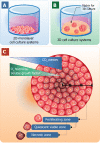Three-dimensional cell culture systems as an in vitro platform for cancer and stem cell modeling
- PMID: 31875869
- PMCID: PMC6904866
- DOI: 10.4252/wjsc.v11.i12.1065
Three-dimensional cell culture systems as an in vitro platform for cancer and stem cell modeling
Abstract
Three-dimensional (3D) culture systems are becoming increasingly popular due to their ability to mimic tissue-like structures more effectively than the monolayer cultures. In cancer and stem cell research, the natural cell characteristics and architectures are closely mimicked by the 3D cell models. Thus, the 3D cell cultures are promising and suitable systems for various proposes, ranging from disease modeling to drug target identification as well as potential therapeutic substances that may transform our lives. This review provides a comprehensive compendium of recent advancements in culturing cells, in particular cancer and stem cells, using 3D culture techniques. The major approaches highlighted here include cell spheroids, hydrogel embedding, bioreactors, scaffolds, and bioprinting. In addition, the progress of employing 3D cell culture systems as a platform for cancer and stem cell research was addressed, and the prominent studies of 3D cell culture systems were discussed.
Keywords: Cancer; Disease modeling; In vitro screening platform; Stem cells; Three-dimensional cultures.
©The Author(s) 2019. Published by Baishideng Publishing Group Inc. All rights reserved.
Conflict of interest statement
Conflict-of-interest statement: No potential conflicts of interest.
Figures



References
-
- Bray F, Ferlay J, Soerjomataram I, Siegel RL, Torre LA, Jemal A. Global cancer statistics 2018: GLOBOCAN estimates of incidence and mortality worldwide for 36 cancers in 185 countries. CA Cancer J Clin. 2018;68:394–424. - PubMed
-
- Westhouse RA. Safety assessment considerations and strategies for targeted small molecule cancer therapeutics in drug discovery. Toxicol Pathol. 2010;38:165–168. - PubMed
Publication types
LinkOut - more resources
Full Text Sources

